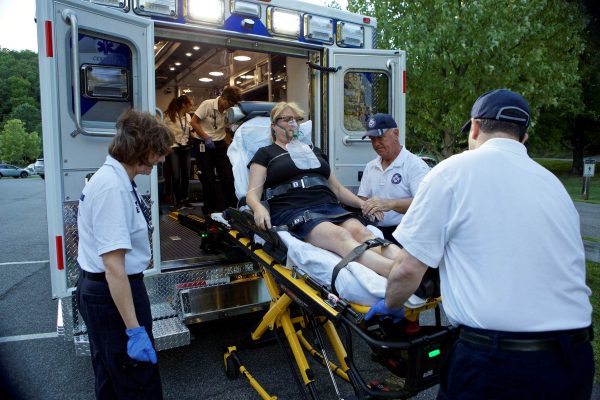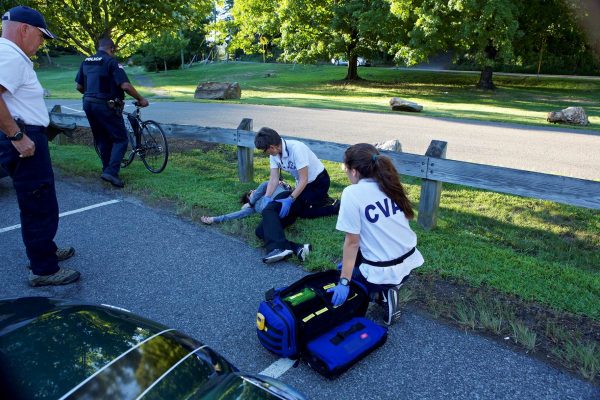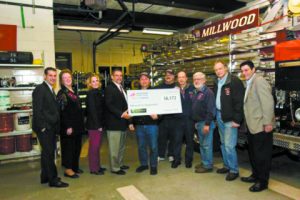Editor’s Note: To protect privacy of injured parties, the footage in this video is a simulated call to depict everyday actions of the Chappaqua Volunteer Ambulance Corps.
In the middle of my tour of the Ambulance building, the 911 alarm rings and five on-duty members of the Chappaqua Volunteer Ambulance Corps quietly go into action. The Driver gets behind the wheel, the Crew Chief hops in next to him. Into the belly of the truck go the EMT, the Aider, a member of the Youth Corps and me. I feel very privileged to have been invited to go out on a call.
The crew has been trained to load and leave within five minutes of the sound of an alarm. As usual, 911 has not been able to tell them much. They know that a car has hit a bicyclist at Gedney Park–the dearth of details will be filled in at the scene, often by the Police who usually arrive first.
The Driver turns on the siren and hopes cars pull over to let him pass so that he can get to the scene as fast as possible. (Reader, do you pull over? If not: Note to self!)
As the ambulance races toward Gedney Park, the Crew Chief rapidly prepares the crew. “Put your gloves on. Bring out a backboard and a collar.”
Arriving at the park, the crew goes into action. Every member knows their role and gets right to it. The Crew Chief attends the bicyclist and the EMT heads to the woman slumped over in the car.
Each exudes calmness and competence as they begin to ask the questions necessary to determine the next steps to take for each patient.

“Did you hit your head?” the Crew Chief asks the bicyclist as she crouches down next to her. “No.” is the response. “Good.” The Crew Chief turns to the Youth Corps volunteer, “She appears alert and oriented.” “Is it to ok if I check you out?” the Crew Chief asks. The bicyclist agrees. “Do you feel pain?” “My arm!” “OK. I’m going to continue checking.” “Does this hurt?,”
she asks as she continues the examination. “On a scale on 1 to 10, what is your pain level–with 10 being the highest?”
“10 for my arm, the rest is ok. Can I call my husband?” “Of course,” the Crew Chief says. She takes out gauze and begins to wrap the arm to restrict movement and reduce the pain in preparation for the move to the ambulance.
The Crew Chief keeps talking, and as she does, the bicyclist becomes visibly calmer. Keeping conversation going is a key component to the assessment because the crew member is doing a couple of things at once. If the patient is talking, she/he often doesn’t realize that the crew member is taking their vital signs and gathering other important information.
With the bicyclist’s arm immobilized and the examination complete, members of the crew bring a “scoop, attach the straps and then lift the bicyclist to the stretcher and head for the ambulance.
“When our son was very young he needed emergency medical attention. I felt helpless and fearful on that day. The CVAC crew who responded to our call were knowledgeable, efficient, and confident but most of all very comforting to us. They knew exactly what to do and assured us that they would take very good care of him. I was so impressed with them that I later decided to join the Corp. CVAC members genuinely care about their community and take great pride in helping others in need. I am proud to be associated with this organization and hope that I am as good at my job as those who responded to my home years ago.” —Marianne Karr
At the same time, the EMT has been dealing with the driver and learned that she has diabetes. The EMT does a blood sugar check–it’s low. She offers a stick of glucose and then brain-protecting oxygen. Next, she begins the body check. No pain, no visible issues. As with the wounded bicyclist, the EMT keeps talking, offering reassurance and letting her know that she will be by her side throughout. The Aider brings the stretcher and the move to the ambulance begins.
This is the kind of call the Chappaqua Volunteer Ambulance Corps (CVAC) answers 24 hours a day, seven days a week. Trained and completely staffed by volunteers, crews routinely rush to homes, traffic accidents, schools, houses of worship, bike paths and businesses.
Last year, CVAC’s 45 members, who range in age from 16 to 75, answered 500 emergency calls. When any one of New Castle’s 18,000 residents dials 911 for a medical emergency, it’s CVAC who responds.
CVAC volunteers are teachers, bus drivers, stay-at-home parents, lawyers, accountants, retired and working professionals.
Working from their headquarters on North Greeley Avenue, donated by the American Legion 80 years ago, this is where CVAC’s two ambulances and one flycar are stored, where training takes place and where volunteers gather during their shifts. Training is ongoing for all members of the corps. Volunteers are taught how to deal with contagions like Ebola, terrorism, flu outbreaks and more. How much does this life-saving service cost us as a community? Zip. CVAC is fully funded through reimbursement from insurance and donations from the community.

What inspires all these extraordinary volunteers to join CVAC? Leslie Jameson, who joined as an Aider and is now an EMT, says, “I drove past a recruitment banner six years ago and decided it would be a good use of my time. I called up and was told that training would be provided and a mentor would be assigned to me. When I went for my first training, everyone was so nice. It felt then–and the feeling has only grown over the years–that I was joining a very special community of men and women.”
CVAC’s Captain Joe Gentilesco was inspired by the crew that came when his father-in-law needed help. “I saw how relieved my family felt when they came and how competently everything was handled. I decided right then that I wanted to be a part of something that was there for people at their most vulnerable moments.”
Reflecting on his five years as a CVAC driver, John Cook said, “I joined to be able to give something to the community. Initially, it was beyond my capabilities but I was trained to do my job first as an Aider and then as a Driver. I find it very interesting and gratifying to be able to help people in their moment of need.”
Be A Lifesaver! The Chappaqua Volunteer Ambulance Corps is always looking for caring committed members of the community who have at least ten hours a week to give. To learn more, call 914-238-3191. Before joining a crew, you will receive training in CPR and first aid. All volunteers begin at the level of Aider and you will always go out on calls with an experienced crew. Call today!
Audrey Brooks feels fortunate to have lived in Chappaqua for 23 years with her three sons and husband Steven Cownie. She is a huge fan of CVAC and grateful for the commitment of its members. A Trustee of the Chappaqua Library and President of the Yoga Teachers Association, professionally, she is a nonprofit consultant, currently working for PowHerNY, a network working toward equal pay for women.
 For more than 75 years, the Chappaqua Volunteer Ambulance Corps has provided emergency care to those who visit, live, or work in New Castle. Today’s volunteers are your neighbors–teachers, lawyers, entrepreneurs, parents, and grandparents. CVAC responds to more than 500 calls annually attending to medical emergencies that include everything from falls and illness to motor vehicle accidents. Volunteers respond to a wide variety of 911 calls, 24 hours a day, 365 days a year. Calls include at home accidents or illnesses, motor vehicle accidents, and any form of medical emergency in our district. Sometimes the patient may decline the ambulance but most times we transport the patient to an emergency room for further medical care. On some calls, paramedics arrive to assume patient care, and we assist them. To volunteer, no experience or background in emergency care is necessary or required; training is free and provided by CVAC.
For more than 75 years, the Chappaqua Volunteer Ambulance Corps has provided emergency care to those who visit, live, or work in New Castle. Today’s volunteers are your neighbors–teachers, lawyers, entrepreneurs, parents, and grandparents. CVAC responds to more than 500 calls annually attending to medical emergencies that include everything from falls and illness to motor vehicle accidents. Volunteers respond to a wide variety of 911 calls, 24 hours a day, 365 days a year. Calls include at home accidents or illnesses, motor vehicle accidents, and any form of medical emergency in our district. Sometimes the patient may decline the ambulance but most times we transport the patient to an emergency room for further medical care. On some calls, paramedics arrive to assume patient care, and we assist them. To volunteer, no experience or background in emergency care is necessary or required; training is free and provided by CVAC. The Ossining Volunteer Ambulance Corps volunteer and career members provide care 24 hours a day, seven days a week, 365 days a year. Members come from diverse backgrounds and walks of life. EMT classes are offered in neighboring communities in conjunction with the Phelps Pre-Hospital Training Department. First Aid and CPR courses are also taught by our members as needed for anyone interested. Volunteers participate in community events such as parades, standbys at church bazaars and street fairs, make presentations in our schools in addition to the primary responsibility of answering emergency medical care calls.
The Ossining Volunteer Ambulance Corps volunteer and career members provide care 24 hours a day, seven days a week, 365 days a year. Members come from diverse backgrounds and walks of life. EMT classes are offered in neighboring communities in conjunction with the Phelps Pre-Hospital Training Department. First Aid and CPR courses are also taught by our members as needed for anyone interested. Volunteers participate in community events such as parades, standbys at church bazaars and street fairs, make presentations in our schools in addition to the primary responsibility of answering emergency medical care calls.
